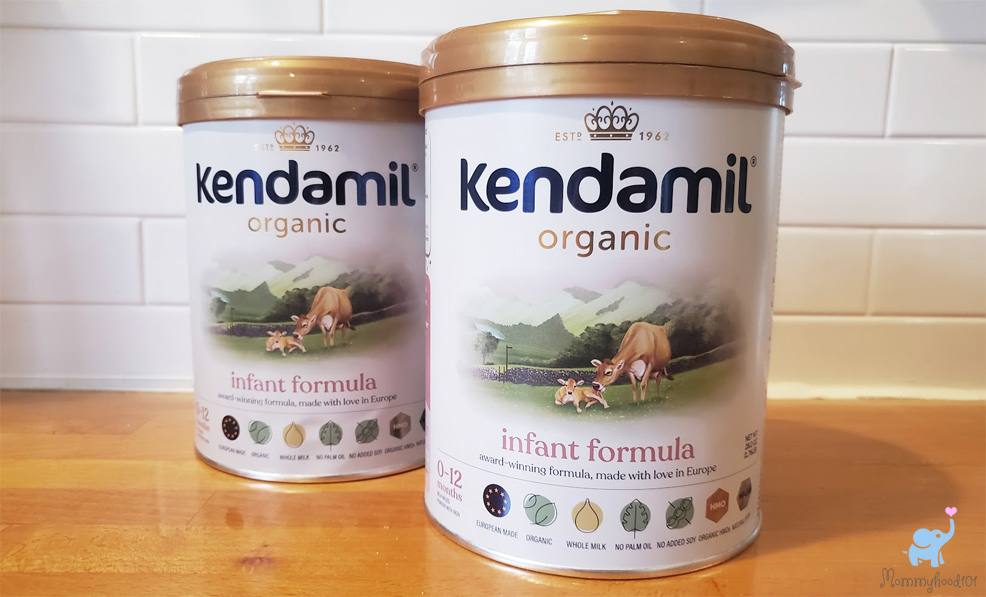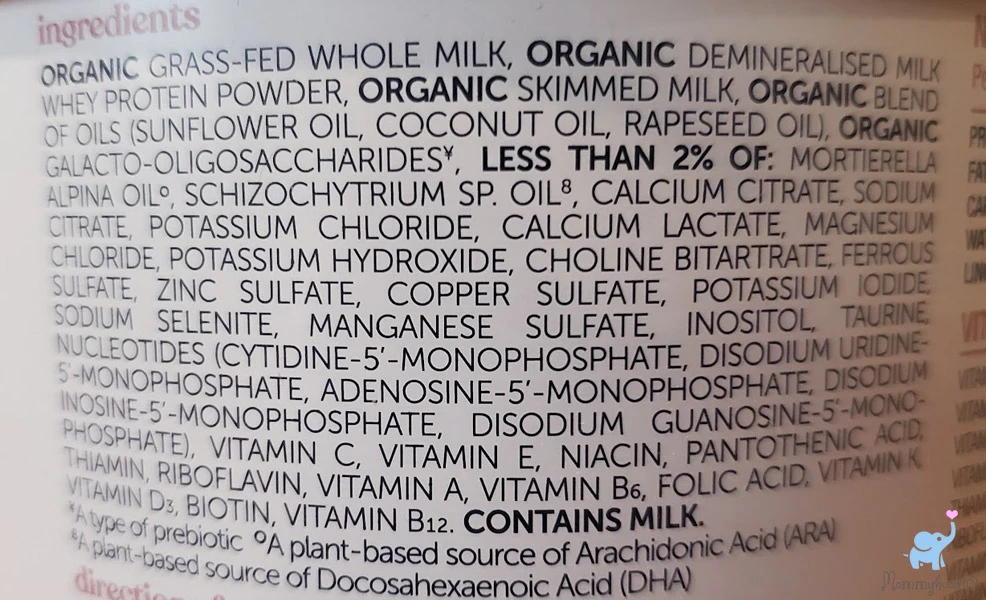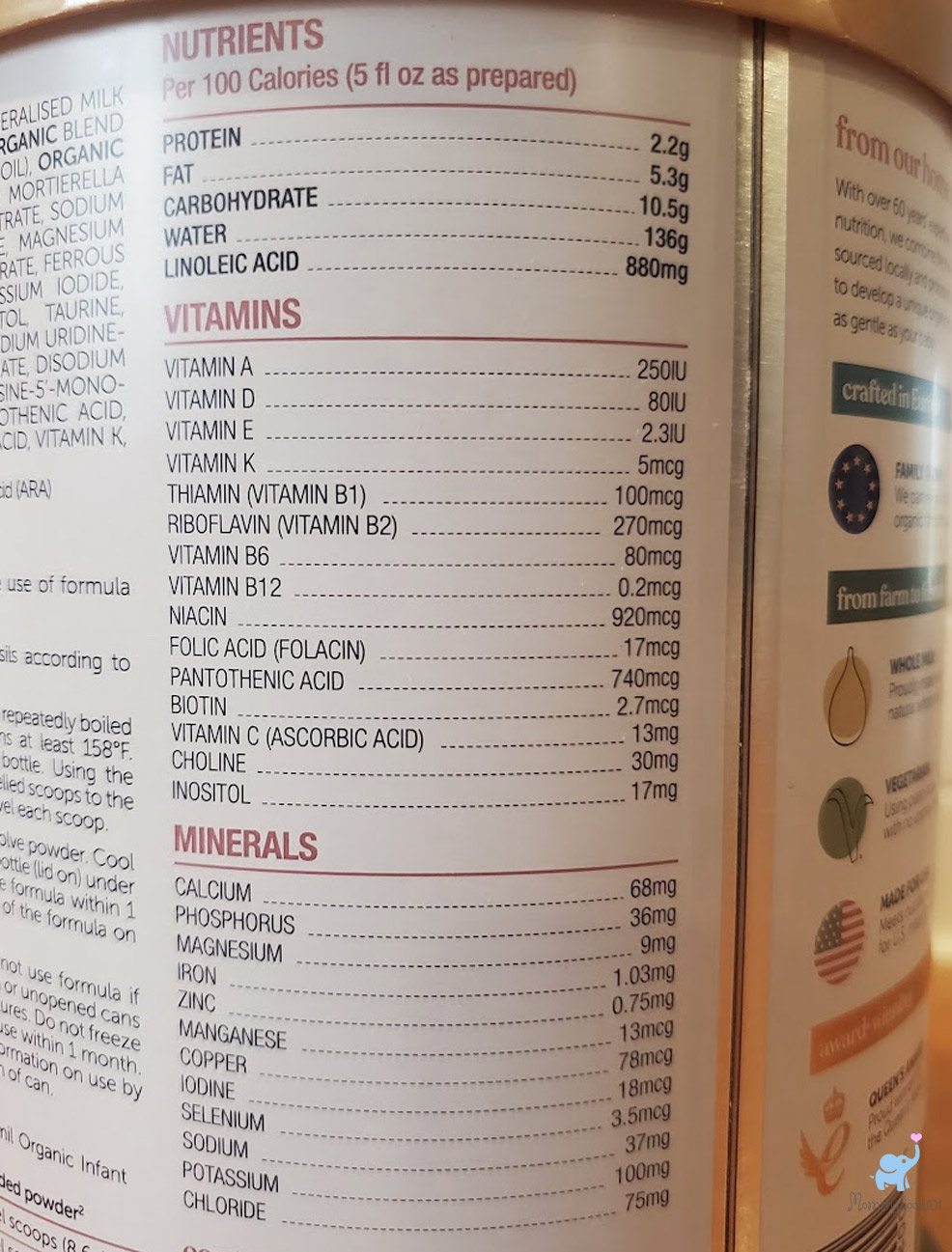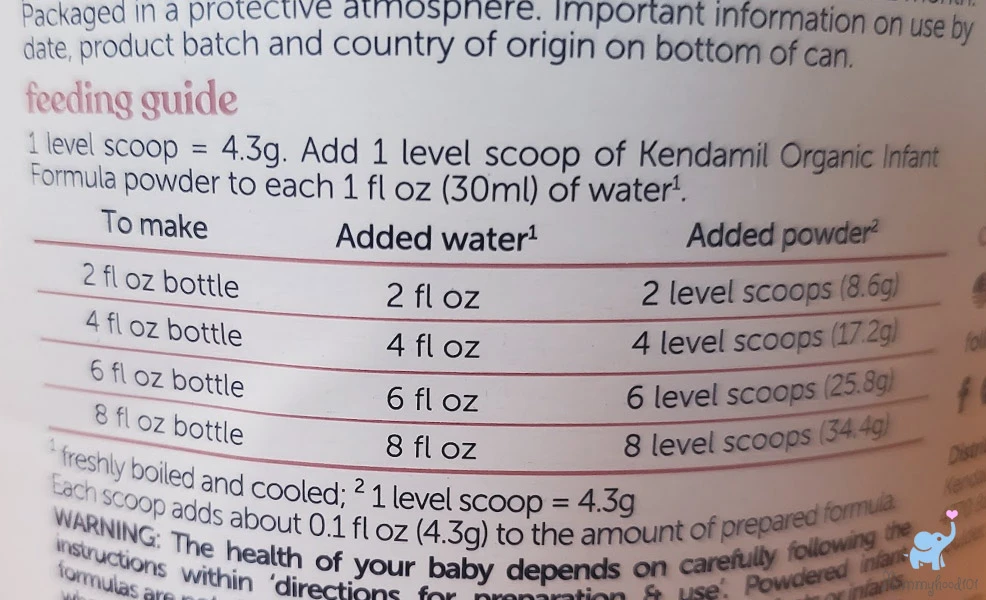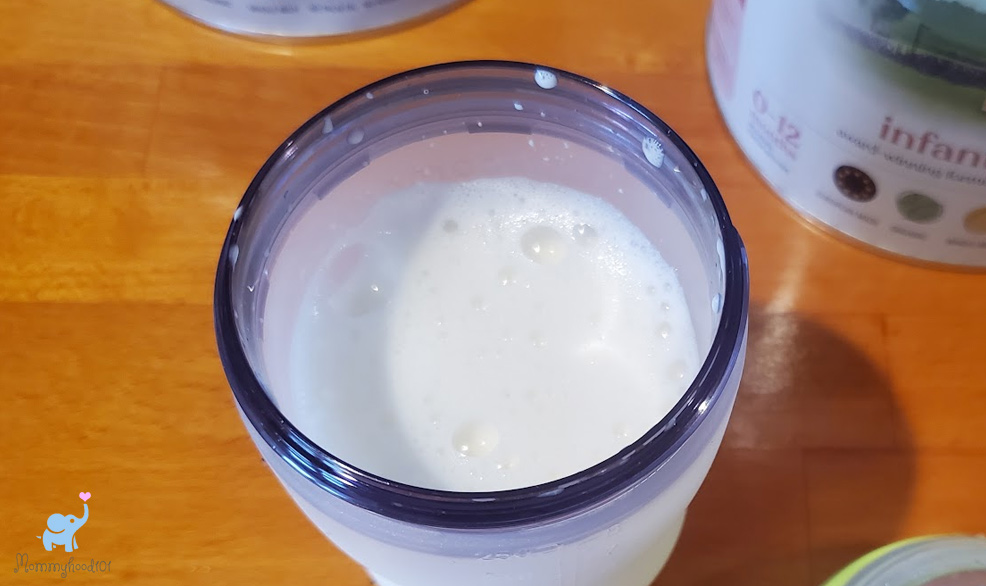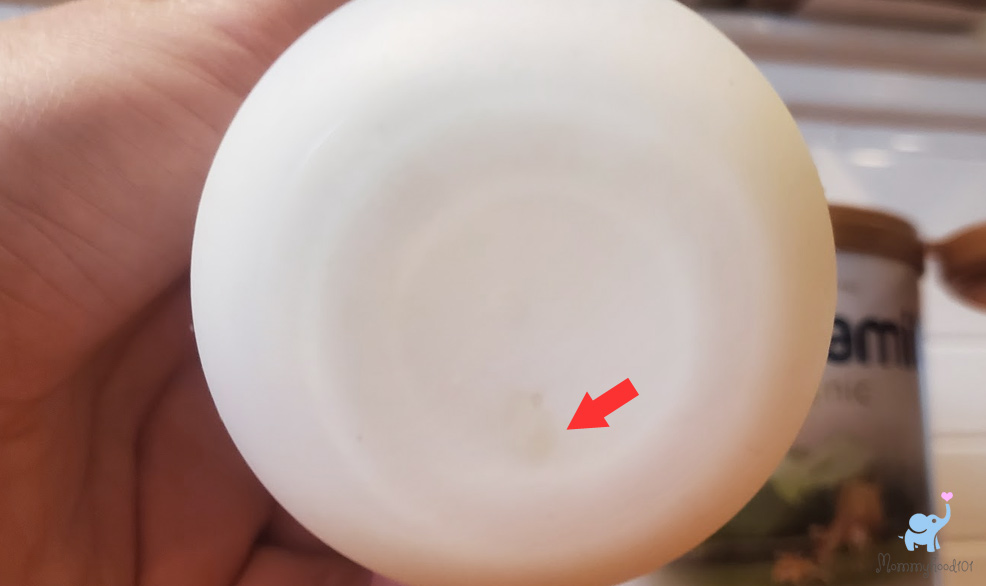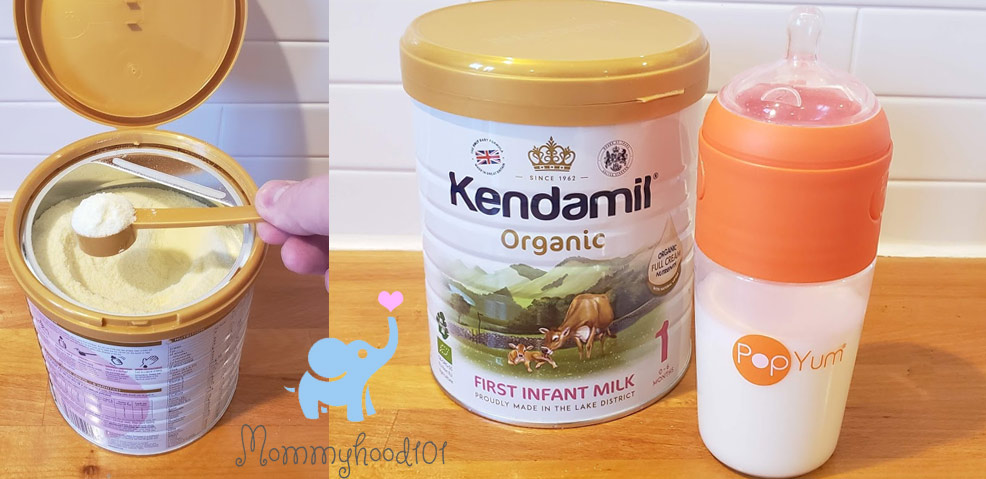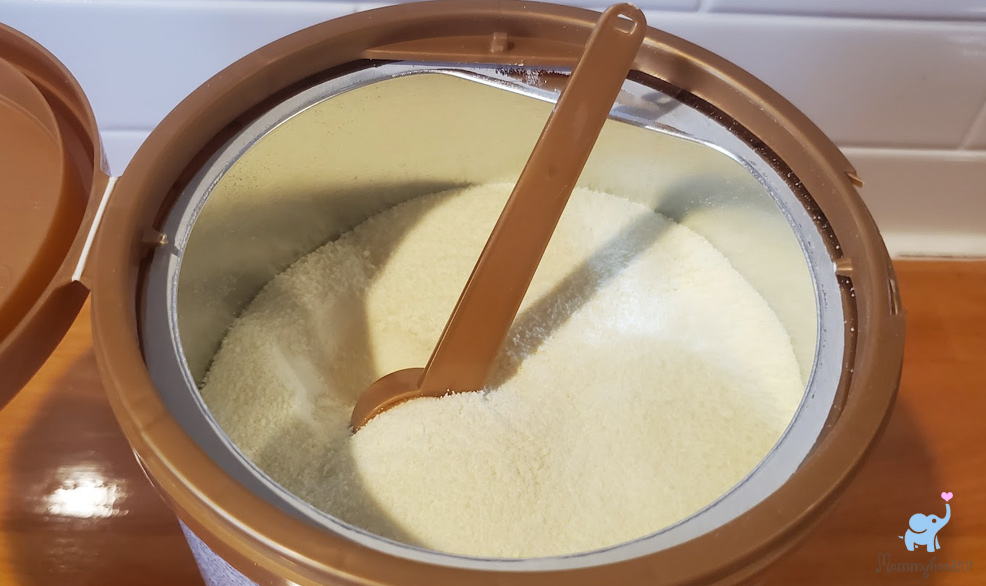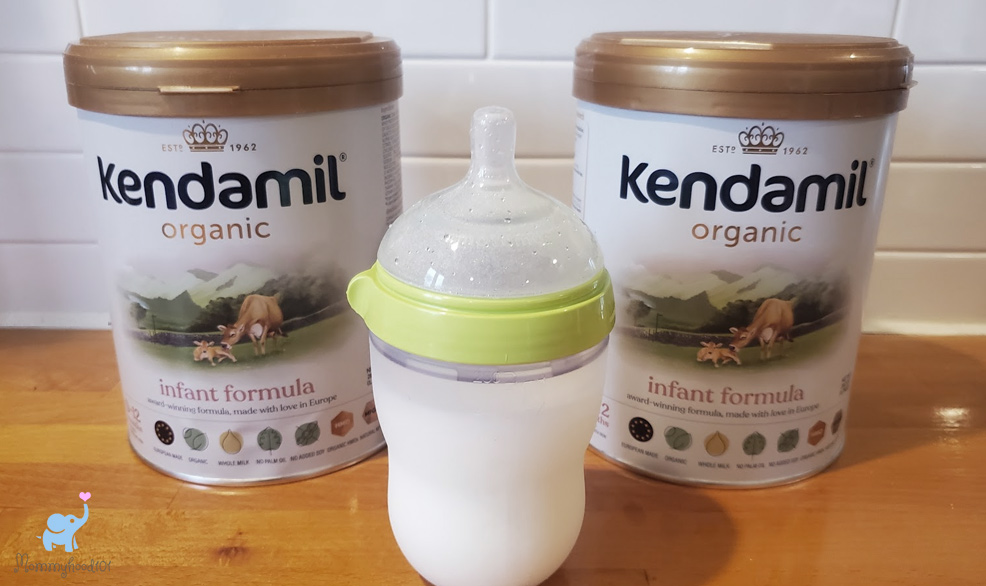This wholesome and nutritious organic baby formula from Kendamil gets our top rating!
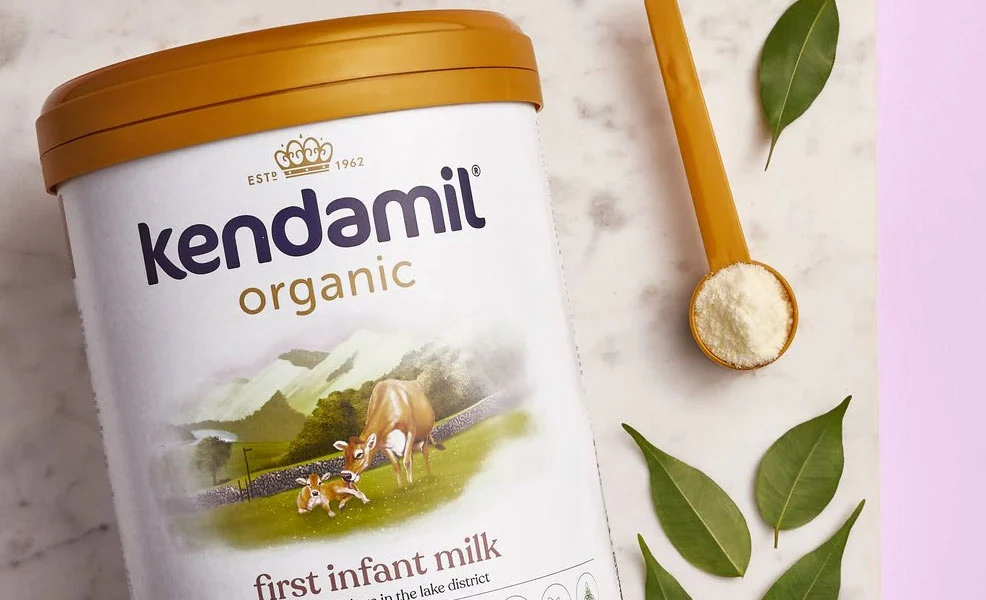
Mommyhood101 independently tests and curates baby gear to help you make informed decisions. If you buy products through links on our site, we may earn a commission.
Kendamil is one of the longest-running baby formula companies in Europe, founded in 1962 and sourcing fresh dairy from family farms in the famous Lake District (a UNESCO World Heritage site), and other formula ingredients from local suppliers in Somerset, Kent, and Yorkshire.
Note: If you're looking for information about the non-organic version of this formula, check out our Kendamil Infant Formula Review here!
Another Note: This article reviews the United States (USA) version of Kendamil Infant Formula, which is suitable for infants from 0-12 months of age. The European version has stages (i.e., Stage 1, 2, and 3, which are suitable for different age ranges).
Kendamil has a long and consistent history of producing high-quality formulas, and in 2018 they released their first organic baby formula. And they didn't cut any corners, providing the first whole cream and palm oil-free infant formula on the European market.
The company's innovation and commitment to quality have resulted in several awards, including the Gold Medal from Monde Selection as the best organic baby formula in the world, and the UK's Board of Trade Award.
As a testament to the trust that British families place in Kendamil, it was used to feed Prince Louis of Cambridge (the son of Prince William, Duke of Cambridge, and Catherine, Duchess of Cambridge), and received the Royal Queen's Award in 2020!
To review Kendamil organic infant formula, we tested it ourselves and consulted with a developmental nutritionist to assess ingredients and nutritional contents relative to USA guidelines.
-
- Kendamil Comparison Table
- Take-Home Message
- Some Translations to Know
- Kendamil Farming Practices
- EU Organic Farming
- Kendamil Organic Ingredients
- Kendamil Nutritional Analysis
- USDA Formula Recommendations
- Kendamil Organic Nutrition Facts
- Testing Kendamil Organic Formula in Infants
- Conclusions
- Where to Buy Kendamil Organic Formula
- References Cited
Kendamil Organic Baby Formula: Take-home Message
Most people don't want to read this entire article to see what we found. So here is the summary of what we loved, and what we didn't.
✔️ High-quality organic formulation.
✔️ British Lakes Region organic milk.
✔️ Nutrition near FDA & USDA standards.
✔️ First ingredient is whole milk.
✔️ Nothing artificial.
✔️ Vegetarian certified (no fish oil).
✔️ No Maltodextrin.
✔️ No sucrose or corn syrups.
✔️ Gluten & soy-free.
✔️ No palm oil.
✔️ Omega-3 via DHA & ALA.
✔️ Omega-6 via LA.
✔️ Inositol, Choline, & Biotin.
✔️ Amino Acids.
✔️ High infant acceptance, good taste.
✔️ No gas, indigestion, or constipation.
✔️ Prebiotics via GOS.
✔️ Milk fat globule membrane (MFGM).
✔️ Human milk oligosaccharides (HMOs).
✔️ Halal (HFA) certified.
❌ No probiotics (but this is UK policy).
No Translations Needed!
Because Kendamil is a British company, all of their labels are in English, so no translations are needed.
This is a welcome addition to the organic baby formula market, making it much easier for American parents to know exactly what they are feeding their babies without relying on a vendor's (sometimes poor) translations.
Best Practices?
Kendamil is made in Great Britain using organic Lakes Region whole milk and EU-certified organic ingredients. Kendamil makes several infant and toddler formulas, including the awesome Kendamil Goat milk formula as well.
Relative to the USDA Organic certification process in the USA, the European Union has stricter organic regulations. Once you receive approvals through the extended certification process, you can display the below (center) star leaf icon on your products.
By comparison, Kendamil meets the 98% minimum organic content requirement of the EU requirement, which is a bit more stringent than the 95% minimum organic content requirement of the USDA's certification process.
What are the EU's organic regulations?
While Kendamil is made in Great Britain which is not part of the European Union, they do sell their products throughout the EU and therefore must conform to broader EU organic requirements.
Fortunately for you, the EU has a very strict system of organic controls, including a rigorous annual inspection process to verify continuing conformance.
Here are the specific organic regulatory criteria for the EU certification process:
- No protecting plants by using synthetic chemicals such as herbicides or pesticides.
- No use of soluble mineral fertilizers.
- No application of chemical growth regulators.
- Feeding animals with farm-grown feed, not purchased feed, when possible.
- No use of antibiotics other than to treat an infection.
Kendamil goes a bit further and only sources their dairy ingredients from within Great Britain, decreasing the risk that any foreign suppliers are not meeting their relatively stringent requirements.
The Kendamil formulas are EU certified by the Soil Association Certification, Ltd, bearing the label GB-ORG-05. Soil Association Certification, Ltd, is a registered organic certification body, located in Bristol, UK.
Kendamil Formula Ingredients
Kendamil organic formula contains very high-quality ingredients and goes beyond British, EU, and US requirements to include Omega fatty acids, amino acids, inositol, choline, biotin, and naturally occurring MFGM and HMOs(more on that later).
The use of locally sourced ingredients from the Lake District and other local regions will provide some intangible benefits for the quality of their infant and toddler formulas. While these benefits may not appear on an ingredients label, this usually means that there is a lower risk of the products containing all the nasty stuff you don't want to occur (even in trace amounts), like pesticides, herbicides, antibiotics, or heavy metals.
Here are the ingredients in the Kendamil organic baby formula:
Kendamil Organic Formula Ingredients (updated 05/24): Organic Grass-Fed Whole Milk, Organic Demineralised Milk Whey Protein Powder, Organic Skimmed Milk, Organic Blend Of Oils (Sunflower Oil, Coconut Oil, Rapeseed Oil), Organic Galacto-Oligosaccharides (A Type Of Prebiotic), Less Than 2% Of: Mortierella Alpina Oil (A Plant-Based Source Of Arachidonic Acid (ARA)), Schizochytrium Sp. Oil (A Plant-Based Source Of Docosahexaenoic Acid (DHA)), Calcium Citrate, Sodium Citrate, Potassium Chloride, Calcium Lactate, Magnesium Chloride, Potassium Hydroxide, Choline Bitartrate, Ferrous Sulfate, Zinc Sulfate, Copper Sulfate, Potassium Iodide, Sodium Selenite, Manganese Sulfate, Inositol, Taurine, Nucleotides (Cytidine-5'-Monophosphate, Disodium Uridine5'-Monophosphate, Adenosine-5'-Monophosphate, Disodium Inosine-5'-Monophosphate, Disodium Guanosine-5'-Monophosphate), Vitamin C, Vitamin E, Niacin, Pantothenic Acid, Thiamin, Riboflavin, Vitamin A, Vitamin B6, Folic Acid, Vitamin K, Vitamin D3, Biotin, Vitamin B12.
Here are some ingredients that we did not find: food starch, maltodextrin, corn syrup or corn syrup solids, palm oil, artificial colors, artificial flavors, preservatives, sucrose, soy, gluten, genetically modified organisms (GMOs), carrageenan, or high fructose corn syrup.
Some ingredients to highlight: There weren't any ingredients we were unhappy with, but here are a few things that stood out:
Natural MFGM: This is milk fat globule membrane, which is a natural membrane that surrounds the tiny bits of fat in real breast milk. Why should you care about this membrane? Research shows that it is correlated with healthy brain development and cognitive outcomes (see references).
Natural HMOs: This is human milk oligosaccharides, which is provided through a unique prebiotic blend. HMOs are considered a highly important component of human breast milk for their role in supporting a healthy gut, immune function, and brain development.
Prebiotics via GOS: This is galactooligosaccharides, which are dietary prebiotics that help promote a healthy gut microbiome through benefits to intestinal microbiota and gut barrier function. Research shows that the prebiotics in infant formula are beneficial for digestion and reducing the rates of gas and colic (and they are more effective than probiotics, see references).
Plant-based DHA Omega 3: Docosahexaenoic acid, or DHA, is commonly sourced from fish. While some parents don't mind this, some prefer a vegetarian option, and some with very sensitive noses don't appreciate smelling a hint of fish oil in their baby formula. Kendamil uses a plant-based DHA, sourced from algae (this is how fish get DHA into their bodies too because algae are in their food chain).
Nutritional Analysis
To examine whether Kendamil organic baby formula comes close to the stringent US nutritional recommendations put forth by the US Department of Agriculture (USDA, see references), Food and Drug Administration (FDA), and American Academy of Pediatrics (AAP), we consulted with a dietician nutritionist with expertise in infant feeding.
Note that the US FDA also publishes minimum infant formula nutritional requirements (see references), but all of the Kendamil formulas meet these published standards (this is why they are approved for sale in the U.S.), and they are only relevant for 0-6 months. Because the Kendamil formulas already meet the FDA minimum requirements, we used the more general USDA daily intake recommendations as a guideline.
The USDA does not publish recommended daily allowances (RDAs) for infants between 0-6 months. Instead, they publish information about Adequate Intake (AI), which is used when there is not enough evidence to make a formal RDA. The AI is set at a level assumed to provide nutritional adequacy.
Here are the USDA's AIs (per day) for infants aged 0-6 months, and 6-12 months. Units are grams (g), milligrams (mg), and micrograms (μg).
USDA Nutritional Recommendations:
| Carbohydrates | 0-6mo: 60g | 6-12mo: 95g |
| Proteins | 0-6mo: 9.1g | 6-12mo: 11g |
| Fats | 0-6mo: 31g | 6-12mo: 30g |
| Omega-3 | 0-6mo: 0.5g | 6-12mo: 0.5g |
| Omega-6 | 0-6mo: 4.4g | 6-12mo: 4.6g |
| Vitamin A | 0-6mo: 400μg | 6-12mo: 500μg |
| Vitamin B1 | 0-6mo: 0.2mg | 6-12mo: 0.3mg |
| Vitamin B2 | 0-6mo: 0.3mg | 6-12mo: 0.4mg |
| Vitamin B6 | 0-6mo: 0.1mg | 6-12mo: 0.3mg |
| Vitamin B12 | 0-6mo: 0.4μg | 6-12mo: 0.5μg |
| Vitamin C | 0-6mo: 40mg | 6-12mo: 50mg |
| Vitamin D | 0-6mo: 5μg | 6-12mo: 5μg |
| Vitamin E | 0-6mo: 4mg | 6-12mo: 5mg |
| Vitamin K | 0-6mo: 2μg | 6-12mo: 2.5μg |
| Folate | 0-6mo: 65μg | 6-12mo: 80μg |
| Niacin | 0-6mo: 2mg | 6-12mo: 4mg |
| Calcium | 0-6mo: 210mg | 6-12mo: 270mg |
| Iron | 0-6mo: 0.27mg | 6-12mo: 11mg |
Given that the Kendamil organic formula is marketed in the USA to be suitable for babies from 0-12 months of age, we evaluated its nutritional content against the USDA 6-12 month recommendations.
Here are the nutrition facts for Kendamil organic formula:
Because the USDA recommendations are for daily intake, we considered the daily intake recommended by Kendamil in their "Feeding Guide."
On their website, Kendamil suggests an average of about 129 grams of formula per day for babies over 6 months of age; of course, this is much lower for the first month (about 86g/day), then increases with age.
Here is the feeding guide for the Kendamil organic formula, from the side of the tin:
To derive an estimate of how much nutritional content a baby would receive each day when using Kendamil, we used the average recommended serving for the first year (about 129 grams of formula per day). This will dramatically overestimate nutrients in early months (like 1-3 months), underestimate them for 4-6 months, and be relatively accurate for later months (like 7-12 months).
As you will see from our analysis, this isn't cause for much concern.
Does Kendamil Organic Formula Meet USDA Nutritional Recommendations?
In general, yes, very similar to US-made baby formulas. Here is a table comparing the USDA recommendation for 6-12 months to what the Kendamil organic formula provides (in about 129g of formula):
| Carbohydrates | USDA: 95g | Kendamil: 63g |
| Proteins | USDA: 11g | Kendamil: 13g |
| Fats | USDA: 30g | Kendamil: 32g |
| Omega-3 | USDA: 0.5g | Kendamil: 0.5g* |
| Omega-6 | USDA: 4.6g | Kendamil: 5.3g |
| Vitamin A | USDA: 500μg | Kendamil: 75μg |
| Vitamin B1 | USDA: 0.3mg | Kendamil: 0.6mg |
| Vitamin B2 | USDA: 0.4mg | Kendamil: 1.6mg |
| Vitamin B6 | USDA: 0.3mg | Kendamil: 0.48mg |
| Vitamin B12 | USDA: 0.5μg | Kendamil: 1.2μg |
| Vitamin C | USDA: 50mg | Kendamil: 78mg |
| Vitamin D | USDA: 5μg | Kendamil: 12μg |
| Vitamin E | USDA: 5mg | Kendamil: 14mg |
| Vitamin K | USDA: 2.5μg | Kendamil: 30μg |
| Folate | USDA: 80μg | Kendamil: 102μg |
| Niacin | USDA: 4mg | Kendamil: 5.5mg |
| Calcium | USDA: 270mg | Kendamil: 408mg |
| Iron | USDA: 11mg | Kendamil: 6mg |
*Kendamil does not disclose Omega-3 levels on their nutrition facts, at least not on the U.S. label. To estimate this, we used the European label, which does disclose Omega-3 contents.
Notice how close those numbers are to each other, with Kendamil meeting or exceeding nearly all USDA nutritional recommendations.
While USDA guidance for carbohydrates and vitamin A is excessively high, the FDA guidance (in 21CFR107.100) is much lower, and Kendamil exceeds them.
Our personal opinion is to follow the FDA guidance; they are the primary regulatory body for infant formula in the USA.
Kendamil levels of most nutrients are actually higher than most European baby formulas such as HiPP Combiotic or Holle Stage 1.
We also compared the Kendamil organic formula nutritional profile with the most popular Similac and Enfamil (American) formulas and found it very similar.
In 2020, the EU passed (well, it was passed in 2016, but enforcement started in February 2020) a requirement that baby formulas include Omega-3, and this is a new addition to most European formulas. This is why you see DHA and ALA appearing in new European formulas.
Most parents begin to introduce solid foods in addition to formula or breastfeeding. These usually first include rice and/or oatmeal cereals, and then progress to fruit and vegetable purees. These will complement the nutrition found solely in the formula, including additional iron and carbohydrates.
Testing Kendamil Organic Formula in Infants
The Kendamil organic formula was donated to us for testing (thanks, Kendamil!).
We tested it with two babies. One was a 2-month-old formula-fed baby (he typically feeds with Similac), and the other was a 6-month-old breast-fed baby (mom has supplemented only twice with formula). The 6-month-old's mom reports difficulties with constipation when attempting to use formula.
Mixing and Taste-Testing
To prepare the Kendamil organic formula, we followed the directions for preparation and use, as indicated on the tin:
- Wash hands, then sterilize your feeding utensils according to the manufacturer's instructions.
- Bring 1 litre of fresh water to the boil (do not use repeatedly boiled water). Let cool for 30 minutes, so it remains at least 158 degrees (F). Measure the required water into a sterilized bottle. Using the scoop provided, add the correct number of levelled scoops to the bottle. Use the straight edge inside the lid to level each scoop.
- Place on a sterilized cap and shake well to dissolve powder. Cool to a natural body temperature by running the bottle (lid on) under cold running water. Once feeding begins, use formula within 1 hour or discard. Always test the temperature of the formula on the inside of your wrist.
The Kendamil organic formula mixes very easily with warm water and doesn't leave any film or residue after preparing the bottle.
As shown in the below photo, we did not experience any excessive foaming or bubbling:
Sometimes when you prepare a baby formula, especially a sensitive formulation, you get clumps of congealed fats settling at the bottom of the bottle.
With Kendamil organic formula, that wasn't really an issue. In the below photo, notice there is only one small clump settled at the bottom. That's great!
In terms of texture and taste, we found it to be very rich and creamy, a lot like the Holle Pre (which also uses whole milk). When we tried it ourselves, it tasted very sweet likely due to the high lactose content.
It has very good flow through slow-flow or medium-flow nipples.
By the way, the tins that Kendamil comes in are amazing and so much easier than the classic cardboard containers, with a flip-top lid and flat inside edge so you can level off the scoops of formula - nice touch!
And the scoop is never hidden, it's attached to the top of the lid - another nice touch!
Safety First: Never prepare powdered formula with anything but water. If you're interested in fortifying your breast milk with formula you must ask your doctor for guidance first, as this can be very dangerous for your baby.
Feeding with Kendamil
The two infants both seemed to take to Kendamil very quickly. Neither rejected it or seemed displeased with it, even the 6-month-old breastfed baby.
Both seemed to like the taste and the bottle-fed baby drank his usual amount or more.
The breastfed baby did develop a bit of gas after, which the mom says is common whenever she's tried formula in the past. We suggested that if she's inclined to continue trying formulas, to attempt one with probiotics to aid digestion, such as the HiPP Combiotik formulas. Note that the UK does not allow infant formulas to contain probiotics, which is why both Kendamil and the UK version of HiPP Combiotic do not contain them.
Overall, we were very impressed with how readily both babies took to Kendamil and tolerated it over time.
The mother of the 6-month-old baby suggested that if she needed to switch to baby formula, she would definitely go with Kendamil organic!
Wondering about that amazing baby bottle? That's the Comotomo, one of the best baby bottles of the year!
Conclusions
This was our first time trying out the Kendamil organic baby formula, and we were really excited to give it a shot.
The organic baby formula market is expanding rapidly, especially in the European market, but it's challenging to compete with companies like HiPP and Holle having ruled this market for several decades.
European baby formulas are becoming increasingly common in the US, as parents look to the EU to find high-quality, organic baby formulas that they can trust (and afford!).
Overall, we are happy to report that we're excited by several aspects of the Kendamil formulas. Whole milk baby formulas are extremely rare and we're happy to see that Kendamil is holding onto this tradition while most other companies are shifting to skimmed milk. We love that Kendamil is also ahead of EU regulations by including not only Omega 3 but also Omega 6 in their formulas (only Omega 3 in DHA form is required at this point in EU), and also including choline, inositol, and amino acids.
While the USA version of Kendamil organic formula does not provide information regarding the proportion of lactose and other carbohydrates, we can make an educated guess based on the European version of Stage 1 Kendamil organic formula; that formula is very lactose-heavy, getting about 92% of its carbohydrates from lactose, just like breastmilk.
The only thing we thought could be improved upon is perhaps the addition of probiotics to aid with digestion in infants with more sensitive tummies, though the UK does not allow these in its formulas.
Overall, the nutritional profile of Kendamil was excellent, coming in near or above FDA and USDA guidelines, which was nice to see and made us feel comfortable using this to not only supplement but also possibly replace breast milk entirely (talk to your doctor first, of course!).
In terms of mixing, taste, and acceptance, the Kendamil formulas were surprisingly similar to breastmilk with a bit more thickness and flavor, and overall acceptance rates were exceptional.
In general, HiPP, Holle, and Kendamil are not only the best baby formulas on the market (in our opinion), but also a bit more expensive than other options. Baby's Only and Lebenswert tend to be a bit less expensive.
Where to Buy Kendamil Organic?
Over the past 10+ years of operating Mommyhood101, we have worked with several companies that import and resell European baby formulas in the United States.
Most of the companies have come and gone, some were pushed out by new FDA labeling requirements for European formulas, and some couldn't maintain their supply chain logistics and tended to ship expired or poorly handled formulas.
One of the only places to purchase Kendamil online in the USA is at the popular website Organic Life Start, which sells a huge variety of formulas to US customers and has some of the best prices.
Not only that, but they have free and super fast shipping!
References Cited
Intestinal Effects of Prebiotic GOS in Infant Formula
MFGM Benefits for Infant Development
Consulting Dietician Nutritionist (Mr. John Anderson)
EU Legislation Requirements for Infant Formula Composition
Consulting Food Sustainability Expert (Dr. Alexi Ernstoff)
United States FDA Infant Formula Nutrient Requirements
United States USDA Infant Nutritional Needs & Recommendations
Published Analysis of Nutritional Contents of European Baby Formulas
Disclaimer: To our knowledge, all ingredient and nutritional information contained in this article was accurate at the time of publication. We make no guarantees regarding the accuracy or timeliness of the information. Always read the packaging and instructions, and consult with your child's pediatrician before making nutritional and feeding decisions. Baby formulas manufactured and labeled for sale in Europe may or may not be approved for sale in the USA by the FDA or other regulatory bodies, so consumer discretion is advised.

